Difference between revisions of "Hudibras"
| Line 13: | Line 13: | ||
|pages=3 pts. in 1 v. ([6], xii, 199, 167, 226, [2], 393-410, [18] p., [17] leaves of plates) | |pages=3 pts. in 1 v. ([6], xii, 199, 167, 226, [2], 393-410, [18] p., [17] leaves of plates) | ||
|desc=(14 cm.) | |desc=(14 cm.) | ||
| − | }}[http://en.wikipedia.org/wiki/Samuel_Butler_%28poet%29 Samuel Butler] (1613-1680) was a poet most famous for his work ''Hudibras'', which he published in three parts, from 1663 to 1677.<ref>Hugh de Quehen, [http://www.oxforddnb.com/view/article/4204 “Butler, Samuel (bap. 1613, d. 1680)”], ''Oxford Dictionary of National Biography'' (Oxford University Press, 2004) accessed 17 Sept 2013. | + | }}[[File:Hudibras1710Frontispiece.jpg|left|thumb|250px|<center>Frontispiece.</center>]][http://en.wikipedia.org/wiki/Samuel_Butler_%28poet%29 Samuel Butler] (1613-1680) was a poet most famous for his work ''Hudibras'', which he published in three parts, from 1663 to 1677.<ref>Hugh de Quehen, [http://www.oxforddnb.com/view/article/4204 “Butler, Samuel (bap. 1613, d. 1680)”], ''Oxford Dictionary of National Biography'' (Oxford University Press, 2004) accessed 17 Sept 2013. |
Unless otherwise noted, all biographical details are from this source.</ref> This book is a coy satire that “explicit[ly] ridicule[d] Puritan folly.”<ref>Ashely Marshall, "The Aims of Butler's Satire in Hudibras." ''Modern Philology'' 105, no. 4 (May 2008), p. 637, accessed September 19, 2013.</ref> This poem was very popular during its time, and established Butler’s reputation for satire. The main character, Hudibras, is a knight that is ridiculed for his Presbyterian qualities, and the plot of the poem has echoes of the Restoration.<ref>Ibid., p. 641.</ref><br/> | Unless otherwise noted, all biographical details are from this source.</ref> This book is a coy satire that “explicit[ly] ridicule[d] Puritan folly.”<ref>Ashely Marshall, "The Aims of Butler's Satire in Hudibras." ''Modern Philology'' 105, no. 4 (May 2008), p. 637, accessed September 19, 2013.</ref> This poem was very popular during its time, and established Butler’s reputation for satire. The main character, Hudibras, is a knight that is ridiculed for his Presbyterian qualities, and the plot of the poem has echoes of the Restoration.<ref>Ibid., p. 641.</ref><br/> | ||
<br/> | <br/> | ||
| − | |||
Butler is marked as an expressive, but neglected, writer known for his ideas about “nonconformist subversion, popish plotting, institutional corruption, and other social questions.”<ref>de Quehen.</ref> He wrote unpublished tracts on politics along with his poetry.<br/> | Butler is marked as an expressive, but neglected, writer known for his ideas about “nonconformist subversion, popish plotting, institutional corruption, and other social questions.”<ref>de Quehen.</ref> He wrote unpublished tracts on politics along with his poetry.<br/> | ||
==Evidence for Inclusion in Wythe's Library== | ==Evidence for Inclusion in Wythe's Library== | ||
| + | Listed in the [[Jefferson Inventory]] of [[Wythe's Library]] as "Hudibras. p.f." This was one of the titles kept by [[Thomas Jefferson]]. Jefferson sold two copies of this title to the Library of Congress, but both copies were missing as early as 1815. Nothing indicates an edition or Wythe's prior ownership of either volume.<ref>E. Millicent Sowerby, ''Catalogue of the Library of Thomas Jefferson'', 2nd ed. (Charlottesville: University Press of Virginia, 1983), 4:518 [no. 4505].</ref> [http://www.librarything.com/profile/GeorgeWythe George Wythe's Library]<ref>''LibraryThing'', s. v. [http://www.librarything.com/profile/GeorgeWythe "Member: George Wythe"], accessed on February 24, 2014.</ref> on LibraryThing indicates "Precise edition unknown. The Library of Congress catalogs call for an edition in 16s. Octodecimo editions were printed at London for John Baker in 1710 and 1711." The [https://digitalarchive.wm.edu/handle/10288/13433 Brown Bibliography]<ref>Bennie Brown, "The Library of George Wythe of Williamsburg and Richmond," (unpublished manuscript, May, 2012) Microsoft Word file. Earlier edition available at: https://digitalarchive.wm.edu/handle/10288/13433</ref> includes the 1709-1710 12 mo edition. The Wolf Law Library followed LibraryThing's recommendation and purchased a copy of the 1710 edition for the [[George Wythe Collection]]. | ||
==Description of the Wolf Law Library's copy== | ==Description of the Wolf Law Library's copy== | ||
| − | Bound in original calf with raised bands and gilt titling to spine | + | Bound in original calf with raised bands and gilt titling to spine. Purchased from Stainbeck Road. |
View this book in [https://catalog.swem.wm.edu/Record/3679302 William & Mary's online catalog]. | View this book in [https://catalog.swem.wm.edu/Record/3679302 William & Mary's online catalog]. | ||
| − | + | ==References== | |
<references/> | <references/> | ||
Revision as of 17:57, 24 February 2014
by Samuel Butler
| Hudibras | |
|
Title page from Hudibras, George Wythe Collection, Wolf Law Library, College of William & Mary. | |
| Author | Samuel Butler |
| Published | London: Printed for John Baker, at the Black-Boy in Pater-noster-Row |
| Date | 1710 |
| Language | English |
| Pages | 3 pts. in 1 v. ([6], xii, 199, 167, 226, [2], 393-410, [18] p., [17] leaves of plates) |
| Desc. | (14 cm.) |
Butler is marked as an expressive, but neglected, writer known for his ideas about “nonconformist subversion, popish plotting, institutional corruption, and other social questions.”[4] He wrote unpublished tracts on politics along with his poetry.
Evidence for Inclusion in Wythe's Library
Listed in the Jefferson Inventory of Wythe's Library as "Hudibras. p.f." This was one of the titles kept by Thomas Jefferson. Jefferson sold two copies of this title to the Library of Congress, but both copies were missing as early as 1815. Nothing indicates an edition or Wythe's prior ownership of either volume.[5] George Wythe's Library[6] on LibraryThing indicates "Precise edition unknown. The Library of Congress catalogs call for an edition in 16s. Octodecimo editions were printed at London for John Baker in 1710 and 1711." The Brown Bibliography[7] includes the 1709-1710 12 mo edition. The Wolf Law Library followed LibraryThing's recommendation and purchased a copy of the 1710 edition for the George Wythe Collection.
Description of the Wolf Law Library's copy
Bound in original calf with raised bands and gilt titling to spine. Purchased from Stainbeck Road.
View this book in William & Mary's online catalog.
References
- ↑ Hugh de Quehen, “Butler, Samuel (bap. 1613, d. 1680)”, Oxford Dictionary of National Biography (Oxford University Press, 2004) accessed 17 Sept 2013. Unless otherwise noted, all biographical details are from this source.
- ↑ Ashely Marshall, "The Aims of Butler's Satire in Hudibras." Modern Philology 105, no. 4 (May 2008), p. 637, accessed September 19, 2013.
- ↑ Ibid., p. 641.
- ↑ de Quehen.
- ↑ E. Millicent Sowerby, Catalogue of the Library of Thomas Jefferson, 2nd ed. (Charlottesville: University Press of Virginia, 1983), 4:518 [no. 4505].
- ↑ LibraryThing, s. v. "Member: George Wythe", accessed on February 24, 2014.
- ↑ Bennie Brown, "The Library of George Wythe of Williamsburg and Richmond," (unpublished manuscript, May, 2012) Microsoft Word file. Earlier edition available at: https://digitalarchive.wm.edu/handle/10288/13433


